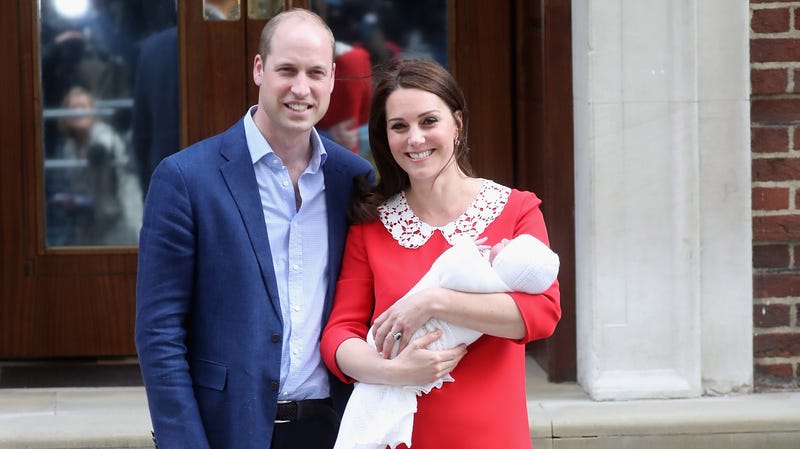
The British tabloids are mad. They are mad because Meghan and Harry have drawn a set of firm boundaries around the birth of their child: They won’t be telling the public every last detail about the birth, and they certainly won’t be posing on any hospital steps like Kate did in 2013, 2015, and 2018 as she and William left Lindo Wing. Instead, they’ll be producing their own photos, and sharing them later.
This news has been poorly received. “Keeping the nation in the dark over details, even after the birth, is a bad look for the royal couple,” wrote the Sun, according a roundup in the New York Times this week. “The public has a right to know about the lives of those largely funded by their taxes. You can accept that, or be private citizens. Not both.”
The royals and the British press have long had a close but dysfunctional relationship—one that vacillates between reverence and vitriol, access and repulsion. But with the arrival of Meghan Markle, that relationship has grown more strained. Though the British press covered the wedding with enthusiasm and excitement, the tabloids also provided a megaphone for all Meghan’s hideous relatives, and their coverage has often had ugly racist undertones. It is no wonder that Harry and Meghan would want to set boundaries.
But for royals, who fundamentally depend upon the media for their throne’s continued existence—there’s no such thing as a king without somebody seeing him as a king—boundaries are all but impossible. They always have been.
Even in the glory days of divine right—when the public considered the monarch appointed by God, someone whose touch could heal the sick—the royals always kept an eye on their public perception. The legal chain of custody for the English throne, in particular, has been less stable than magnets sold to tourists at Buckingham Palace gift shop tend to suggest; historically, a wildly unpopular king always risked rebellion from landed nobility, who with the right amount of muscle could scrape up somebody legitimate enough to make a play for the throne. And, too, the intimate matters of the monarch’s body were a matter of state importance; historically, the Home Secretary and other officials attended the births of new heirs, a legacy of the 17th century “warming pan scandal,” when rivals to the Stuarts suggested that James II’s son was in fact a pretender, smuggled into the queen’s bedchambers via a warming pan, to secure the succession.
Advertisement
In the United Kingdom, over the course of several centuries the crown’s power waned, so that by the 19th century the country was a constitutional monarchy and Queen Victoria found herself with little formal control. To protect the crown, she and her consort Prince Albert enshrined the royal family as a symbol, the upright bourgeois heart of the great British nation, distributing the image through the burgeoning press of the era. This carefully crafted paradigm took the occasional hit—Victoria’s tomcatting son Prince Edward, the Wallis Simpson debacle and the couple’s attendant coziness with Nazis—but it has essentially dominated the monarchy’s playbook over for two centuries. Even after the antics and rancor of the ’80s and ’90s nearly decimated decades of careful branding work, the Windsors have managed to boomerang back to this basic model.
Yet this strategy relies on the media to distribute the all-important image. Victoria and Albert savvily shaped their likeness: the reason we picture Victoria as the cap-wearing imperial grandmother to a nation is that she propagated that particular look by embracing photography. (Speaking to the BBC History Extra podcast, historian Lucy Worsley speculated that in fact she may have opted for giant dresses to avoid wearing a corset, to avoid irritating an abdominal hernia sustained in childbirth.)
This is the reason for the annual Christmas radio address that gradually morphed into the television address; this is the reason for the royals’ enthusiastic embrace of social media. Buckingham Palace (i.e., the Queen’s staff), Clarence House (Prince Charles’s staff), and Kensington Palace (which handles the Cambridges and, until recently, Harry and Meghan as well) all embraced Instagram and Twitter long before Meghan, with her experience running the lifestyle website The Tig, arrived on the scene.
Advertisement
Remember that Twitter video, posted by Kensington Palace, where Harry and Queen Elizabeth herself playfully beefed with the Obamas to promote the Invictus Games?
Like so many other celebrities, the Windsors have embraced the possibilities of social media to cut out the press and, as much as possible, to set their own narrative. Think of how frequently Kate has taken the official photos of her children that are distributed to papers across the world. It’s a careful curation of a public image that rivals that of Beyoncé.
Advertisement
But unlike the Carter family, the royals need the media, fundamentally, in order to maintain what power remains to them, and ensure the continued existence of their throne. The monarchy is a fiction which continues to exist on certain terms; it’s a bargain that demands payment. Without the media, the royals are just random rich people born into an outdated hereditary system of power. A defunct royal title maybe gets you a byline in Vogue, but it doesn’t get you much real power on the world stage.
And so for Harry and Megan, the wedding was a whirlwind, but it was also the easy part—generating enormous goodwill and a triumphant, positive storyline for the family. But the narrative logic of the tabloids demands drama, and after the triumph comes the fall. Hence Harry and Meghan will spend the rest of their lives calculating how much access is the right amount of access; whether the bits they dole out will placate the media or simply encourage them to dig and dig and dig.
https://jezebel.com/the-monarchy-is-a-fiction-1834271186
2019-04-25 15:30:00Z
52780277028933
Tidak ada komentar:
Posting Komentar